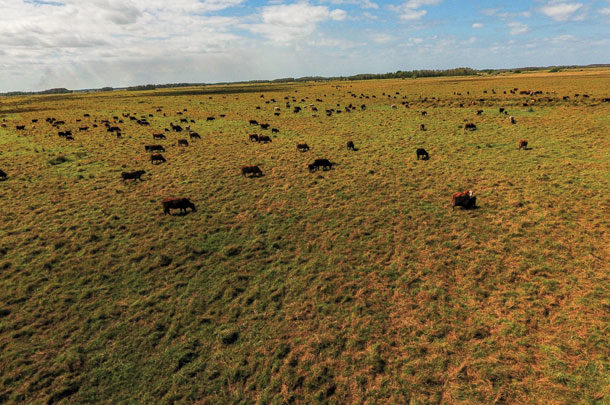Ryegrass is a popular cool-season choice for pastures and hay mixes, known for its rapid growth rate, high yields and nutrient-dense content. While offering numerous benefits, ryegrass is not without unique challenges regarding management and nutritional capabilities. When managed properly in a pasture, forage or hay seeding mix, this grass can have quality comparable to high-value alfalfa.
Background and profile
Ryegrass is a bunch-type grass that tends to establish itself best in climates that are cool and moist. Being quite succulent and lush, it tends to be lower in dry matter than similar grass counterparts but still has high yields throughout its growing season.
Besides coming in annual and perennial varieties, ryegrass comes in two other categories: diploid and tetraploid.
Diploid ryegrass plants have two sets of chromosomes in each cell. Diploid ryegrass varieties tend to have smaller plant structures and finer leaves but more dry matter due to the low water content within the plant cells.
“The diploids have an advantage where they tend to form a denser stand. They have more tillering capability; this can make them more resilient to hoof traffic,” explains Mike Trammell of the Noble Research Institute.
This high-tillering capability makes them very competitive with any weeds, he says. They are also more tolerant of lower-fertility conditions and places that tend to be very wet.
Alternatively, tetraploid plants have four chromosomes per cell. Tetraploids are slower growing than diploids and don’t have as much tillering capacity, making them less persistent in pastures with heavy hoof traffic.
“When you talk about forage quality and the difference between the two, they’re both very good,” says Trammell. “But tetraploids tend to be a little better because they have a larger cell size. This means they have a higher percentage of cell contents, or soluble carbohydrates, and a lower amount of fiber content, making plants highly palatable to grazing livestock.”
However, tetraploid plants tend to have a higher water content because of the larger cell size, which can reduce intake compared to diploids.
Comparing the performance of annual versus perennial varieties depends on region. Perennial ryegrass is primarily adapted to temperate climates. However, in the Southern Great Plains region, perennial ryegrass doesn’t seem to persist as well, attributed to seasonal droughts.
In the Upper Midwest, it can also suffer in harsh winter conditions. Annual ryegrass is primarily grown in the Southern and Coastal Plains all the way to the East Coast, Trammel explains.
He says that annual varieties can be grown as a pure stand or be interseeded with a small grain such as rye, oats, triticale or wheat. In the South, annual ryegrass is a great option to overseed warm-season grasses such as bermuda, thus extending the grazing season several months.
Nutritional and seeding advantages
Similar to other grasses, ryegrass nutrition is heavily dependent on climate, harvest and management.
“If it’s harvested in the vegetative stage very early in maturity, it can have more than 20 percent protein and can be as nutritious as alfalfa,” says Dr. Bill Weiss, professor of dairy cattle nutrition at Ohio State University. “The digestibility of fiber can be extremely high, well in excess of 60 percent, where alfalfa is down around 40 or 50 percent.”
Dale Sansom runs cow-calf and stocker operations at Sansom Ranch in Ashdown, Arizona. He no-till seeds 750 to 1,000 acres of ryegrass at least annually. He grows a mix of Tetrastar, Gulf and Marshall varieties.
“Ryegrass will really put the gains on your cattle,” he says. “We graze it all winter and spring and then bale it if needed to allow our bermuda to grow.”
For fibers, including neutral detergent fiber (NDF), it will never be quite so low as alfalfa, but it can be in the mid to upper-40s level, but this is almost totally dependent on stage of maturity when harvested. For a grass, this makes ryegrass especially advantageous and a great option as a silage or pasture mix for dairy producers.
“Ryegrass is usually less expensive to establish than alfalfa, and because it is a grass, it can be an excellent forage for manure application,” says Weiss.
For graziers, ryegrass also has a lot of strengths in a pasture mix. In the southern region of the country where Trammel is, a lot of farmers use it to overseed and get some early spring grazing before other grasses come up.
“They usually get about 30 to 40 days of grazing before the grass breaks dormancy,” says Trammel. “In this area, it will be grazed two different ways: It will be interseeded with a small grain such as a wheat or older rye cereal, or another common use, especially throughout the southeastern U.S., is overseeding a warm-season, perennial grass with it, such as bermudagrass.”
Ryegrass, due to its high moisture content and tonnage, tends to fill up grazing animals fairly quickly. This, coupled with the hoof durability of the diploid variety, makes it resilient in grazing and difficult to graze down too quickly.
Disadvantages
A conversation that sometimes accompanies ryegrass is the risk of toxicity. Sometimes known as “ryegrass staggers,” the condition is caused by fungus endophytes in perennial varieties.
This condition is most common overseas, particularly in New Zealand with the Lolium perenne variety. However, this is not a concern in the U.S., and cases of this happening are extremely rare.
However, there are certain instances where ryegrass should be avoided. While perennial ryegrass contains similar protein and mineral concentrations as other cool-season grasses grown under the same conditions, it tends to have higher concentrations of soluble carbohydrates.
Laurie Lawrence, equine nutritionist from the University of Kentucky, notes this can be a concern if grazed by horses at risk for laminitis.
“If the perennial ryegrass will be grazed by broodmares, endophyte-free varieties should be used,” she says.
Similarly, Weiss warns that immature ryegrass, being high in energy at peak harvest, may be too rich for heifers and cause them to be overconditioned.
If your pasture mix is not diverse enough, there is also a concern that heavy ryegrass grazing will satisfy animals quickly due to high water content, and it can overgrow very quickly when not maintained.
To prevent ryegrass from becoming too prolific, be mindful of how heavy you seed it, and make sure you keep your pastures stocked adequately to prevent it from overpowering other forage types.











